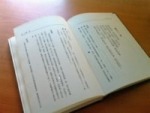Lao Tzu and Taoism Wisdom
How to Read Tao Te Ching

The most notable book on tao and taoism, Tao Te Ching (道德经), known as Lao Tzu, was written by Lao Tzu more than 2,000 years ago.
It is an all-time favorite philosophy book from China, and is said to be the most translated text after Bible.
As a book of such prominence, one would have expected it to be colossal. It is, nevertheless, pretty modest in terms of length.
The book consists of 81 verses, many of which are of just a few lines. It is divided into two parts; 37 and 44 verses respectively. The first part is known as Tao (道), which means ‘The Way’ (德); and the second, Te, which means ‘The Virtue’.
The whole book adds up to only about 5,000 Chinese characters -- a length that allows you to learn it by heart, if efforts are made.
While terse, the verses are tremendously profound, and each requires repeat readings to have its profundity revealed. They are poetic, enigmatic, and at the same time, rich, powerful and inspiring.
Little is known about its author
Lao Tzu (lao zi). He is revered as founder of Taoism, and believed to
live in the 4th century BC, during the Warring States Period -- an era
of vibrant cultural and intellectual development in ancient China.
Read further on Tao Teh Ching
Click here to read more about Lao Tzu.
How to Read the Book
The book is often read in the sequence of chapters.
While containing only 5,000 Chinese characters, it is mind-boggling. Put it at your desk or your bedside. Read a chapter or two at every one sitting. Do not rush. Let the Tao in it unravel! You are on your way to wisdom in taoism. It is a river of wisdom. So profound that a sip or two is enough to fascinate! For me, every revisit is a new journey.
While it may sound mystical, Tao Te Ching is not a book of religion. It nevertheless has exerted tremendous influence on the religion in China.
The English versions of Tao Te Ching are usually longer, due to technicalities of translation. There are many translations around, both online and in hard copies. Choose one that you can relate to best.
While reading the book, you may want to use the framework that I have developed to facilitate the understanding of Tao. It is intended to introduce the key concepts, and help you to apply Tao to things you do every day.
The framework consists of the following sections:
Tao Basics
This
section introduces the key concepts of Tao Te Ching and taoism. They
include non-doing or wuwei, silence, and yin-yang equilibrium. It also
talks about Tao’s role in religion.
Click here to read about key concepts of Lao Tzu and taoism.
Tao Personal Potential
With Tao, you unleash your
hidden potential, as if peak performers displaying their splendor. All
peak performers are natural exponents of Tao when they perform.
Click here, to find out more about Tao and hidden potential.
Tao Leadership
"The best leader is one his people
barely know that he exists," says Lao Tzu. Such leaders however are few
and far between. All too often leaders exert authority and interfere
too much. Learn to harness the power in people instead, so as to access
to an immensely different energy field to work with.
Click here, to read more about Tao leadership.
Tao Personal Effectiveness
Harness the power of
nature, in addition to your own, and you will be many times more
effective. Learn to let go, while staying detached and behaving simply.
You will see your effectiveness grow.
Click here to read about Dao and Personal Effectiveness.
Tao Health
Tao Te Ching has been used over
thousands of years as a manual for achieving longevity. There must be
good reasons. Find out why, and read about Tao activities like stress
relief, meditation, tai chi and qigong.
.
Click here, to read more about Tao health.
Other Notable books on Tao
In addition to Lao Tzu, there are many other notable works on tao and taoism.
The
most prominent among them is I Ching, also known as Yijing. Written
more than 5,000 years ago with its first versions written on oracles,
it is one of the oldest surviving books of the world.I Ching is
regarded as the most prominent of all Chinese classics. The yin-yang
concept introduced in Tao Te Ching is given full treatment in I Ching.
To read more about I Ching, click here.
Chuang Tzu is another prominent philosopher of Tao and Taoism. In
his book, know as Chuang Tzu or Zhuangzi, the philosopher introduces
tao and taoism by using fables, making Tao comprehensible. I quote a
number of his fables on this website.
Translations
For your convenience, I have included the translation by J.H. McDonald for your reference. It is quite a good translation.
Click here to read the translation.
Go to Home Page
